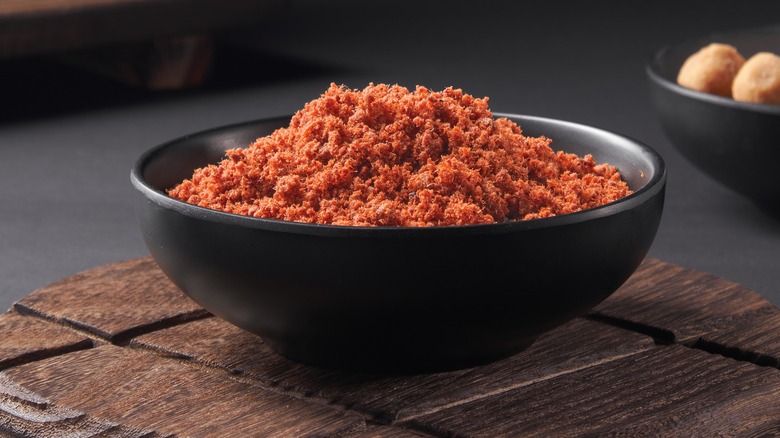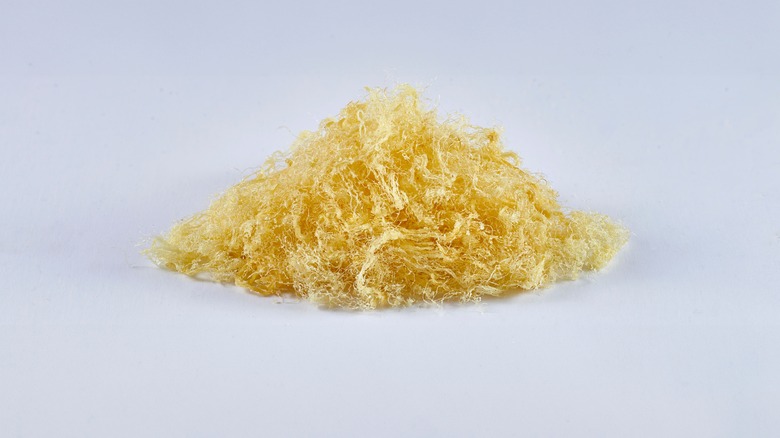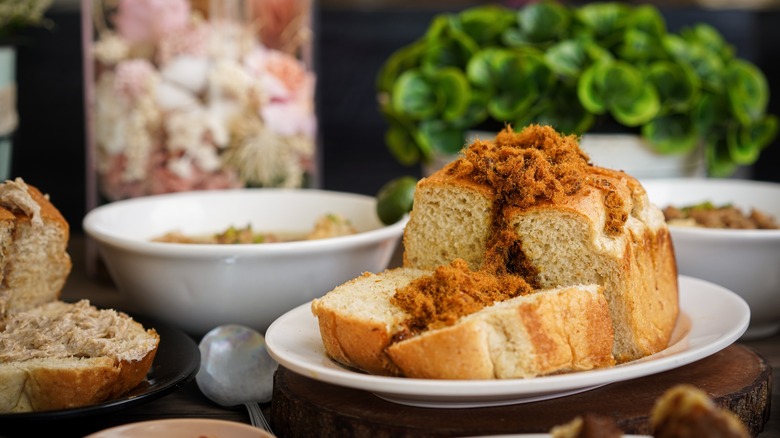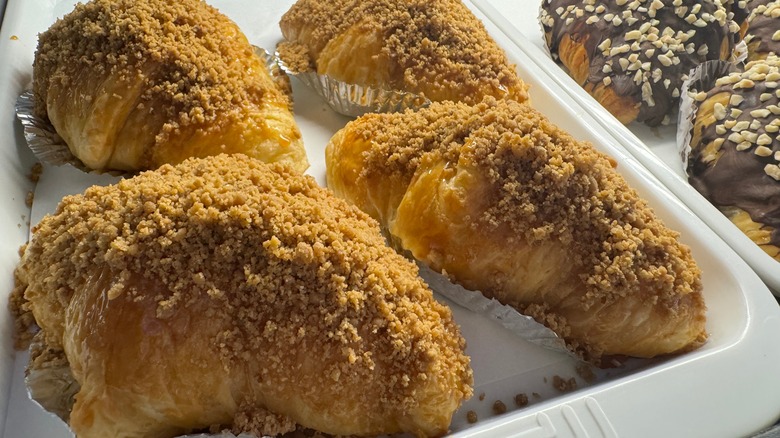Pork Floss Isn't What It Sounds Like
In the United States, dehydrated meat typically alludes to pricey store-bought beef jerky meant as a protein-dense snack when you're on the go. However, there are certain varieties meant for the kitchen, like the Asian favorite pork floss. Don't let its name confuse you, though — this food won't get stuck in your teeth. Affectionately referred to as pork cotton candy, its texture is fluffy yet slightly meaty, with a quality that dissolves once it comes into contact with moisture.
And the flavor only enhances the hard-to-pin consistency. Pork floss's sweet, salty, and savory notes all come into play a little differently, depending on the context. The foodstuff can be used in baked goods and even ice cream, as well as atop vegetables, stir fries, in wraps, with congee, and more. Throw in the fact it can be kept in a jar at room temperature and its easy-to-use nature cements its popularity — buy it once and you'll always want it on hand.
It's made from fried meat shreds
Pork floss can be created through a straightforward stovetop process. It starts with a meaty pork cut that packs in balanced fat: sirloin, shoulder, or tenderloin are common candidates. The slab is first boiled in saltwater for a few hours to make it soft and shred-able. After stirring it into shreds, these porky morsels are seasoned with a variable mix of salt, sugar, and spices. Common candidates include soy and oyster sauce, Shaoxing wine, white pepper, and perhaps MSG. Some work in the additions during the final minutes of simmering, while others toss them with the pork once dry.
Next, the shredded pork hits the wok, with either a very small amount of oil or none at all. The dry-frying crisps up the pork through dehydration rather than seeping oil throughout the meat. To avoid burning, the temperature is kept very low, and the whole process lasts as long as an hour. Once no moisture remains, the meat is shredded once more, oftentimes with a food processor or industrial machinery. Although the condiment is possible to craft at home, most purchase it in premade jars. It's found in a less fried variety called pork fu and the darker, more seasoned and shredded pork sung. In most uses, either will do — just be aware that their palate's differ slightly.
A wide range of traditional applications employ pork floss
Pork floss is a common staple in numerous Asian cuisines, with noted popularity in China, Malaysia, Singapore, Taiwan, and Vietnam. As a result, it comes with a diverse range of traditional uses, which are tried and true vessels for the foodstuff. In the many shades of Chinese cuisine, pork floss is used in congee, like a ginger chicken jook. The meat texturally diversifies the rice porridge while adding a sweet-savory touch.
Pork floss is also especially beloved in Taiwan, where it's used alongside everything from fried rice, as a filling in onigiri, and in baked goods. Such doughy creations are especially well-known: Renditions like light and airy pork floss milk bread or flavored savory rolls are renowned. And for breakfast, you'll find pork floss with eggs wrapped in scallion pancakes, served alongside other essential Taiwanese dishes.
Meanwhile in Malaysia, pork floss is known as bak hu and casually complements many foods. It's filled between slices of toasted bread with butter and used as a delightful topping for dried noodle dishes and stir fries to provide contrasting bright flavors. In Vietnam, it's a frequent complement to rice dishes and sold as a street snack in Saigon alongside crisps. Here, the dehydration technique for making floss goes beyond pork and is used to cook birds and fish as well. You'll even find it as a filling in banh mi, solidifying the ubiquitous nature of the dried meat.
Keep a jar handy for creative uses
No doubt, such traditional applications are worthwhile reasons to get ahold of pork floss. However, the applicability of the foodstuff expands even further — keep it on hand to sprinkle on a wide range of dishes. Malleable like a delicious chili oil you won't be able to live without, pork floss lends a delightful combination of savory and sweet flavors. For breakfast, throw it on your morning eggs, pancakes, or even oatmeal. Come lunchtime, it'll complete a salad, accentuate pasta, or make for a more filling baked potato. And in dinner contexts, it can be like the fried onion topping atop a casserole or even mingle with the sweetness in baked beans.
Rather than a foreign ingredient that requires expertise, think of it like the casual condiment that's always available. And if you prefer a certain flavor, whip a batch with your favorite seasoning. In Nigeria, it's made with hot curry powder, while a similar Mexican dish called machaca combines small strands of beef with oregano and garlic. Experiment and see what works for you!



